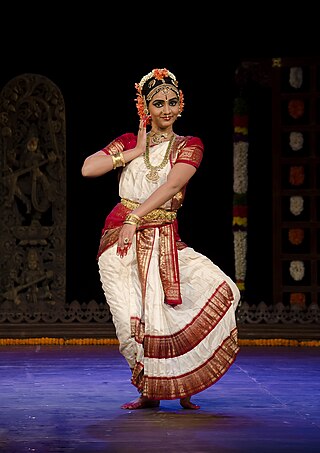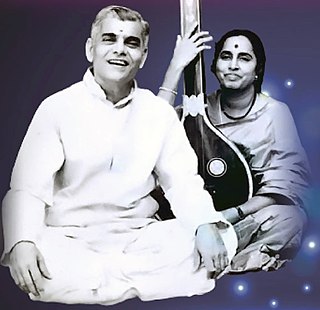
Bharatanatyam is an Indian classical dance form that originated in India. It is a classical dance form recognized by the Sangeet Natak Akademi, and expresses South Indian religious themes and spiritual ideas, of Hinduism and Jainism.

Kuchipudi is one of the eight major Indian classical dances. It originates from a village named Kuchipudi in the Indian state of Andhra Pradesh. Kuchipudi is a dance-drama performance, with its roots in the ancient Hindu Sanskrit text of Natya Shastra. It developed as a religious art linked to traveling bards, temples and spiritual beliefs, like all major classical dances of India.

Semmangudi Radhakrishna Srinivasa Iyer was an Indian Carnatic vocalist. He was the youngest recipient of the Sangeetha Kalanidhi awarded by the Music Academy in 1947, a distinction he holds to this day as of 2023, probably the only musician to receive that honour before reaching 40. He had received many other awards as well, including Padma Bhushan and Padma Vibhushan from the Government of India, Rajyasevanirata title from Travancore's erstwhile ruling family, Sangeet Natak Academy award (1953), Isai Perarignar from Government of Tamil Nadu and Kalidas Samman from Government of Madhya Pradesh. He was affectionately addressed as "Semmangudi Maama" by his disciples. He was also considered the "Pitamaha" or the grand sire of modern Carnatic Music. He was conferred with an honorary doctorate by University of Kerala in 1979.

Padma Subrahmanyam, is an Indian classical Bharata Natyam dancer. She is also a research scholar, choreographer, teacher, Indologist and author. She is famous in India as well as abroad; several films and documentaries have been made in her honor by countries such as Japan, Australia and Russia. She is well known as the developer and founder of the dance form Bharata Nrithyam.

Sonal Mansingh is an Indian classical dancer and Guru in Bharatanatyam and Odissi dancing style. She has been nominated by the President of India to become a Member of Parliament, Rajya Sabha. She is the recipient of Padma Bhushan in 1992 and Padma Vibhushan in 2003.

Palghat Kollengode Viswanathan Narayanaswamy, often referred to as K. V. Narayanaswamy was an Indian musician, widely considered to be among the finest Carnatic music vocalists of the 20th century. He was awarded the Madras Music Academy's Sangeetha Kalanidhi in 1986. He was described as the "Perfect Knight" of Carnatic music, a phrase from Geoffrey Chaucer, by V. K. Narayana Menon, art critic of India and recipient of the Sangeet Natak Akademi Fellowship.

Bala is a 1976 documentary film made by Satyajit Ray, about a Bharatanatyam dancer, Balasaraswati, fondly known as "Bala". The film was jointly produced by National Centre for the Performing Arts and Government of Tamil Nadu. The thirty-three-minute documentary features the life and some of the works by Balasaraswati in the form of narration and dance, starring herself. At the age of fourteen, Ray had seen a performance of Balasaraswati in Kolkata, then known as "Calcutta", in 1935, when she was seventeen years old.
Tanjore Viswanathan was a Carnatic musician specializing in the Carnatic flute and voice.
Tanjore Ranganathan was a Carnatic musician specializing in percussion instruments, particularly the mridangam, having studied under Palani Subramaniam Pillai.
T.N. Ramachandran was an Indian art historian, artist, archaeologist and a Sanskrit scholar, specialising in the study and exposition of various aspects of Indian art. He was born to Narayanan & Visalakshi. He was the author of several monographs, and was the director-general of archaeology in India. He conducted research and wrote extensively on various subjects during his tenure as curator of archaeology at the National Museum, New Delhi.

Chitra Visweswaran is an Indian Bharata Natyam dancer who runs a dance school, the Chidambaram Academy of Performing Arts, in Chennai.

Vannadil Pudiyaveettil Dhananjayan and Shanta Dhananjayan, together known as the Dhananjayans, are an Indian dancing couple who were awarded the Padma Bhushan in 2009.
Urmila Sathyanarayana is an Indian classical dancer of bharatanatyam.

Kalanidhi Narayanan was an Indian dancer and teacher of Indian classical dance form of Bharatnatyam, who was the early non-devadasi girl to learn the dance form and perform it on stage in the 1930s and 1940s. After a brief career in the 1940s, she returned to dance in 1973 and became a notable teacher of abhinaya.

Kumari Kamala is an Indian dancer and actress. Initially featured as a child dancer, Kamala appeared in almost 100 Tamil, Hindi, Telugu and Kannada films throughout her career. In the 1970s, she became a teacher of the Vazhuvoor style of dance in which she specialises.

Harinie Jeevitha is an Indian classical dancer and choreographer. The disciple of Smt Sheela Unnikrishnan of Sridevi Nrithyalaya, she started dancing at the young age of six in the Melattur style of Bharathanatyam (Bharatanatyam).
Aniruddha Knight is an artist of the Indian classical dance and music known as Bharatanatyam. He is a 9th-generation descendant of a 200-year-old family of dancers and musicians from southern India. The dances are traditionally performed by women - Knight is unusually the first male of his family to take up this style of dance. His grandmother Balasaraswati was a celebrated and prolific dancer, Newsweek said she has been "recognized as the greatest Indian dancer of all time".
Bala Devi Chandrashekar is a Bharatanatyam dancer and teacher based in Princeton, New Jersey, United States. She was trained under Dr. Padma Subrahmanyam. Bala Devi Chandrashekar is a Professor of practice in Asian performing arts. Her approach is interdisciplinary, involving lecturing and research. Bala Devi's unique well researched productions include Nandanar Charithram, Krishnaarpnam and Uddhava Gita.
Madras Kadiravelu Saroja, known as Puliyur Saroja, was an Indian classical dancer, known for her expertise, as an exponent and as a teacher, in the classical dance form of Bharatanatyam. The Government of India honored her, in 2011, with the Padma Shri, the fourth highest civilian award, for her services to the field of art and culture.
Meenakshi Chitharanjan, an Indian classical dancer, teacher and choreographer, is known as an exponent of the Pandanallur style of the classical dance form of Bharatanatyam. She is the founder of Kaladiksha, an institution promoting Bharatanatyam and striving to preserve the Pandanallur tradition. A disciple of the father-son duo of Chokkalingam Pillai and Subbaraya Pillai, she is a recipient of several honours including Kalaimamani Award of the Government of Tamil Nadu and the Natya Kala Sarathi of Sri Parthasarathy Swami Sabha. The Government of India awarded her the fourth highest civilian honour of the Padma Shri, in 2008, for her contributions to classical dance.












